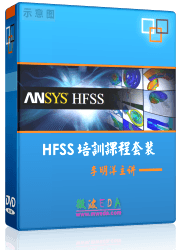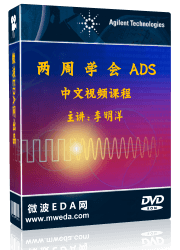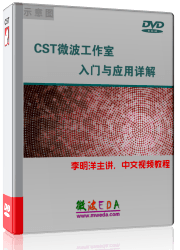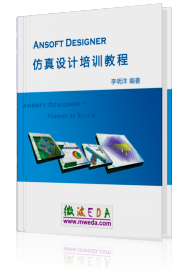Mesh Problem Handling
This page contains a list of the most important warning and error messages
in the meshing context together with a detailed explanation of the meaning
and proposal for handling and resolution.
Contents
Hexahedral Mesh
Mesh representation
Matrix generation
Tetrahedral Mesh
Hexahedral Mesh
Mesh representation
The radius of wire "xxx"
is greater than some of the adjacent mesh lines.
The wire radius of discrete port "xxx" is greater than some of
the adjacent mesh lines.
The wire radius of lumped element "xxx" is greater than some
of the adjacent mesh lines.
When a wire (a bondwire or a wire part of discrete
edge ports or lumped edge elements) is defined with a finite radius (r>0),
but not modeled as a solid, this warning can appear. In that case the
hexahedral solvers simulate the wire as a chain of segments along hexahedral
mesh edges and try to consider the finite radius using a so-called thin-wire
model. This semi-analytical technique locally modifies the algorithm along
this chain. However, the thin-wire model can only be applied, as long
as the size of the adjacent mesh cell is bigger than the given wire-radius
(meaning the complete wire radius is located in the first neighbored mesh
cell). The warning now indicates, that in some regions the adjacent mesh
lines are smaller than the wire radius, which no longer allows the internal
usage of the thin-wire model. In any case the connectivity of the wire
structure is not affected.
Solutions:
In very complex geometries (e.g. PCB structures
with many bondwires), this warning might be negligible, since the effect
only happens locally.
For bondwires in less complex models (e.g. simple
transitions between microstrip- or cpw-lines) the radius of a wire has
a more significant effect on the results and should therefore be taken
into account. In that case the flag "Solid wire model" on the
Make Wire from Curve dialog page could be activated, which allows the
more accurate 3D-wire handling by PBA and TST.
In order to have easy switches between the different
wire models, you also find a button "Simplify model..." in the
Solver dialogues, where wire models can be switched for all existing wires
at a central place rather than editing each wire separately.
Not enough
longitudinal points for port number "xxx". The space in front
of the port needs to be at least 3 cells long.
Waveguide for port number "xxx" is too short. The waveguide must
be homogeneous for at least three mesh planes along propagation direction.
The transient solver needs a small homogeneous structure
and mesh region in front of the port (in propagation direction) in order
to apply the port mode extraction and imprint in a correct way. These
warnings are shown when the geometry in front of the port is inhomogeneous
or smaller than three mesh cells. In this case please check the model
setup.
Not enough transversal
points for port number "xxx" to calculate the desired number
of modes.
Port number "xxx" has very few transversal points to calculate
the desired number of modes. This may lead to inaccurate mode patterns.
This warning usually occurs when the mesh in the
port region is very coarse. During the calculation of port modes the number
of unknowns are compared with the number of desired modes. In principle
one degree of freedom is needed to represent one mode, if this is not
given the solver stops with the first message as an error. However, also
with just a few more unknowns the accuracy of the modes might be affected
and the second message is shown as a warning. In both cases the solution
would be to refine the mesh in the port area or to check whether some
unwanted metal object is located in the port region.
Port number "xxx"
and "yyy" have overlapping areas in mesh representation. Consider
to decrease the port dimension or to refine the mesh distribution.
Port number "xxx" and "yyy" have adjacent areas in
mesh representation. Consider to decrease the port dimension, to activate
electric port shielding or to refine the mesh distribution.
In case of overlapping or adjacent port areas in
mesh representation the mode extraction and imprint of the ports cannot
work correctly anymore. In order to resolve the problem, the mesh should
be refined in this region to allow a disjunct setup of the ports. In principle
it is also possible to reduce the dimension of the corresponding port
areas, but only when the mode patterns are not strongly affected by this
change. In case of adjacent and not overlapping ports it is also possible
to activate electric shielding on the port dialog to realize some kind
of decoupling between the ports.
Matrix generation
Shape "xxx" was internally
patched to maintain watertightness.
It might happen that the surface of a solid body
is not completely closed. This might be caused by a CAD model imported
from a different vendor.
During the process of matrix generation the surface of the respective solid
body is repaired automatically in order to run the hexahedral based solver
correctly. The repaired part of the shape is shown in the mesh view of
the project. The original CAD model remains unchanged.
Some shapes of the CAD model overlap
each other.
This warning provides a hint that some parts of
the geometric model overlap each other. A numerical simulation of such
a model is still possible if mesh type "FPBA" is used. However,
in the overlap region of the overlapping shapes one shape is preferred
and therefore used for the simulation setup. More detailed information
about the overlapping shapes can be found in the solver log file.
Detected regions with short-circuited
PEC/PTC material. (This may happen if the mesh is too coarse in regions
where small gaps are embedded in PEC/PTC material).
The internally used representation of the geometric
model is limited regarding the resolution of geometric details if the
mesh type "FPBA" is used. If the mesh is very coarse compared
to the geometric detail within one mesh cell it might happen that parts
of the geometry touch each other although they are actually not connected.
If this situation is detected the warning above appears.
Solution:
To avoid unintended short-circuits it might help
to increase the number of mesh lines around the short-circuited shapes.
Port "XXX" is inhomogeneously
filled within the first 3 mesh cells. Cannot start solver.
The first 3 mesh cells in front of a waveguide port
must be filled homogeneously regarding the orientation of the port.
Solution:
Please modify the mesh line distribution or the
geometric model to meet this requirement.
Parts of the CAD model referring
to the sensitivity parameters "xxx" and "yyy" are
located within TST cells and will be ignored during the sensitivity analysis.
This might reduce the accuracy of the sensitivity results.
TST cells are currently not supported for the time
domain sensitivity analysis. It might help to increase the mesh line distribution
at locations where TST cells appear.
"xxx" mesh cells are represented
in staircase mode and have been filled with PEC/PTC.
"yyy" mesh faces are represented in staircase mode and have been
filled with PEC/PTC.
Depending on the chosen hexahedral solver this warning
might appear. It means that within a mesh cell or a mesh face a certain
geometrical configuration cannot be used to run the solver correctly.
Therefore these cells or cell faces are filled with PEC or PTC depending
on the chosen problem type. However, in many cases these filled cells
do not influence the simulation results significantly. The staircase based
cells can be seen in the mesh view.
Solution:
Please make sure that the mesh is not too coarse
at locations where the staircase based cells appear.
Depending on the chosen problem type, please activate the "Use TST
cells" checkbox if provided in the "Mesh Properties - Hexahedral->Specials...->Advanced"
dialog box.
The point accuracy setting for the
PBA matrix calculation seems to be low. In some rare cases this might
lead to inaccurate simulation results.
To increase the point accuracy enter the
Mesh  Global Properties Global Properties  Specials... Specials...  Advanced dialog box and set the "Point accuracy
enhancement" value to a higher number. Advanced dialog box and set the "Point accuracy
enhancement" value to a higher number.
During the process of matrix generation with mesh
type "PBA" the internally used geometric accuracy limitations
might not be suitable to run the chosen hexahedral solver.
Solution:
Setting the point accuracy to a higher value will
increase the internally used accuracy.
Please note, the default point accuracy setting will provide good results
in most cases. Increasing the point accuracy setting might increase memory
usage and solver run time.
Parts of the geometry cannot be processed
properly with mesh type "PBA". This might cause inaccuracies
during simulation. Please consider using "FPBA" (
Mesh  Global Properties Global Properties  Specials... Specials...  Mesh type). Mesh type).
For high accuracy requirements consider activating "Enhance FPBA accuracy"
as well.
The "PBA" mesh type provides results of
very high accuracy. However, in some rare situations this meshing technique
might not reach the desired accuracy, e.g. due to an improper geometric
setup caused by importing CAD models of a different vendor.
Solution:
If this warning appears the "FPBA" mesh
type provides a solution which is much less sensitive to improper geometric
data.
It is recommended to also activate "Enhance FPBA accuracy" to
get the same level of accuracy as with mesh type "PBA".
Matrix calculation failed with mesh type
"PBA". Please consider using "FPBA".
(Mesh Properties->Specials...->Mesh type). For high accuracy requirements
consider activating "Enhance FPBA accuracy" as well.
The "PBA" mesh type provides results of
very high accuracy. However, in some rare situations this meshing technique
might fail, e.g. due to an improper geometric setup caused by importing
CAD models of a different vendor.
Solution:
If this error appears the "FPBA" mesh
type provides a solution which is much less sensitive to improper geometric
data.
It is recommended to also activate "Enhance FPBA accuracy" to
get the same level of accuracy as with mesh type "PBA".
Port x contains n decoupled regions.
Please consider defining one port for each of these regions.
This warning may occur when multiple decoupled regions,
e.g. multiple coaxial waveguides, are present in one port definition.
Solution:
A typical cause for this problem is the case where
the port is both shielded by "electric shielding" or an electric
boundary condition and by geometry. Here a simple solution would be to
deactivate "electric shielding" or to set another boundary condition.
The topology of port x
has changed after adaptive port meshing. This could influence the 3D simulation
as well as the port modes.
This case occurs when the port is inaccurately meshed.
Solution:
If mesh type "PBA" is selected,
please consider using "FPBA" with "Enhance FPBA accuracy"
(Mesh Properties->Specials...->Mesh type). The problem may also appear
when the mesh density in the port region is insufficient to capture all geometric detail.
In this case, a higher mesh resolution could solve the problem
(Mesh Properties->Specials).
Tetrahedral Mesh
Following regions contain degenerated
elements... Generating a finer mesh for listed
regions or removing small features may help.
The quality of some tetrahedrons is low.
Please consider improving the initial mesh.
The so-called "Low quality elements" may
occur during the tetrahedral mesh generation in the CST MWS frequency
domain solver. Very "flat" or very "thin and high"
tetrahedra are typical examples.
The presence of low quality elements can influence
the solution in two ways:
Influence on the mesh
adaptation process: Low quality elements in the initial mesh can negatively
affect the mesh adaption process. During the mesh refinement in the mesh
adaptation, more refinement steps are typically needed in order to obtain
a good final solution. Influence on the solution's
accuracy: Low quality elements which also have large dihedral angles worsen
the condition number of the matrix. This typically leads to larger numbers
of necessary iterations in the iterative solver, and may also lead to
less accurate solution.
What to do:
you can try to improve the quality of the initial mesh by adjusting the
mesh parameters:
Local mesh parameters
(select object, then right mouse button -> Mesh properties): in the
areas in which low quality elements occur, you can choose a smaller mesh
step for the individual objects concerned: this typically leads to better
mesh quality. Global mesh parameters
(Mesh -> Mesh properties): if you choose a larger number of steps per
wavelength, as well as "Smooth density transitions" in the "Specials
- Volume mesh" dialog, the overall mesh will be finer and of better
quality. Other techniques:
very thin metallic sheets can be modeled, in a first step, as having zero
thickness. To do this, first select the relevant faces, then use Objects
-> Face healing -> Shape from picked faces to create a sheet object.
This technique results in a better quality of the mesh, which can often
compensate the small geometric inaccuracy thus introduced.
The length ratio
between the shortest and the longest model edges is 1: xxxx. This is often
caused by modelling thin metallic layers by using solids. If this is the
case here, it may be advantageous to model the metallizations as infinitely
thin sheets.
This warning occurs only, when tetrahedral meshing
is used. The tetrahedral mesher is much more sensitive to the initial
mesh quality. The effects of this will be apparent in the adaptive meshing
process and solve time (poorly conditioned matrix due to "low quality
elements"). To avoid "Low quality elements" we typically
recommend modeling thin conductors as zero-thickness sheets. This can
easily be accomplished by picking the face of the microstrip where it
meets the substrate. Then in the face healing tools, the option to make
shape from picked faces will create the sheet. If the thickness is a critical
feature (edge coupled microstrip for example), you can set the maximum
mesh step by right-clicking on the object and entering the mesh properties
dialog. This helps keep the tetrahedrons from having a very long aspect
ratio.
If any curved surface exists,
please consider increasing the "Curved element order" in the
"Specials..." of the tetrahedral mesh properties to obtain more
accurate results.
This message is a hint that curved elements are
not yet enabled for your model. It is displayed even if no curved surface
or model edge exists, in which case the following recommendation to use
curved elements does not apply. Curved elements provide a better approximation
of the geometry than linear elements. The latter are a special case of
the former: linear elements are "curved" with a "curved
element order" of One. This "curved element order" can
be increased in the special
tetrahedral mesh properties. For the default "Second" order
solver elements, a "curved element order" equal to Two or Three
is recommended. Further increase the value for higher solver order.
"xxx"%
of all mesh cells do not resolve the wavelength properly. They are larger
than "yyy" times the wavelength.
The solver has found that the size of some mesh
cells with respect to the wavelength in their material seems to be too
large. As the "worst case" wavelength in media usually is considered
for the generation of the initial mesh even for dispersive materials,
most of the mesh cells should be sufficiently small, already before any
adaptive mesh refinement is applied. Exceptions may exist for coupled
simulations, where the material parameters are not known at the time of
mesh generation.
If there is wave propagation in the concerned materials, results may become
inaccurate. Furthermore, the iterative solver may need more time and memory.
Please check the mesh settings and the material properties. The mesh may
need manual refinement, or settings which result in a finer initial mesh.




HFSS视频教程
ADS视频教程
CST视频教程
Ansoft Designer 中文教程
|